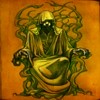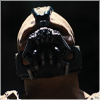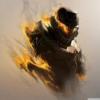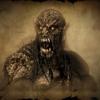Cirith Ungol was build by Gondor as a forward defense against Mordor, and after the return of Sauron in later 3rd Age its function must have been somewhat similar, i.e. to ensure that Orcs or Men didn't escape from Mordor. Compared to the forces gathered at Minas Morgul the garrison of Orcs at Cirith Ungol was rather insignificant, so an uruk as commander of the orcs there is rather logical; as far as I remember he also had to obey orders from "higher up" ... the Nazgûl of Minas Morgul.
Some further explanation on this:
from 'The Tower of Cirith Ungol':
Shagrat's company had seemed to be about forty, and Gorbag's more than twice as large; but of course Shagrat's patrol had only been a part of his garrison.
Shagrat was the 'Captain of the Tower', i.e. the tower of Cirith Ungol, and Gorbag was an Orc-captain send from Minas Morgul. As the two groups in the end succeeded to kill each other, we must assume, that the garrison of Cirith Ungol was not greater than about a hundred orcs.
As a comparison the forces from Mordor (excluding allies), at the Battle of the Pelennor Fields, did at least count some 20.000 orcs; some were troops from Barad-dûr and Morannon, but the greater part probably from Morgul. The allies from Harad, Khand and Rhûn were estimated minimum 25.000.
This gives us an estimated total of about 50.000 troops under the command of the Witchking and Gothmog.
An army of this size and diversity of units would require an efficient command-structure to function properly, and this indicates a structure of several levels;
one of the ways to solve the problem of Gothmog's identity is to assign to these levels the possibilities that have been listed so far: the Nazgûl, the Black Númenoreans, Boldogs and Orcs (and for the allies Commanders of Men, too).
Some hints:
- Sauron is (of course) important. He may have had a strong will-power, but it was limited (without the One Ring) ... he was mainly acting through his most loyal servants.
- Don't focus on the Battle of the Pelennor fields only. There were other battles as well, and the dates of their occurence shows that they were very well planned and coordinated ... there are small clues scattered around on the various battlefields.
- Don't forget the invasion in the south [battles at Linhir(!) and Pelargir(?)] ... some clue on the importance of Khand [and the Black Númenoreans(?)]

(this is from 'History of Middle-earth' only, and it's not easy accessible. sorry) - Forget about movie-lore and especially GW-lore and the like; it'll only confuse you and lead you astray.
On Shagrat and Gorbag:
Before they started fighting, the two captains had an interesting dialog, where some of their remarks give an small insight in the command-structure of Mordor's forces:
from 'The Choices of Master Samwise':
'Hola! Gorbag! What are you doing up here? Had enough of war already?'
'Orders, you lubber. And what are you doing, Shargrat? Tired of lurking up there? Thinking of coming down to fight?'
'Orders to you. I'm in command of this pass.'
[...]
[Gorbag] 'Oho! So they haven't told you what to expect? ... they can make mistakes, even the Top Ones can.'
[Shagrat] 'They may, but they've got eyes and ears everywhere; ... there's no doubt about it, they're troubled about something. The Nazgûl down below are, by your account; and Lugbúrz is too.'
...
[Gorbag] 'The messages go through quicker than anything could fly, as a rule. But I don't enquire how it's done. Safest not to. Grr! Those Nazgûl give me creeps. And they skin the body off you as soon as look at you, and leave you all cold in the dark on the other side. But He likes 'em; they're His favourites nowadays ...'
...
[Gorbag] '... I'm not easy in my mind. As I said, the Big Bosses, ay,' his voice sank almost to a whisper, 'ay, even the Biggest, can make mistakes. [...] A message came: Nazgûl uneasy. Spies feared on Stairs. Double vigilance. Patrol to head of Stairs.'
On the Nazgûl of Minas Morgul, there's this piece of lore:
from 'Unfinished Tales: The Hunt for the Ring', note 1)
According to the entry in the Tale of Years for 2951 Sauron sent three, not two, of the Nazgûl to reoccupy Dol Guldur. The two statements can be reconciled on the assumption that one of the Ringwraiths of Dol Guldur returned afterwards to Minas Morgul but I think it more likely that the formulation of the present text was superseded when the Tale of Years was compiled; and it may be noted that in a rejected version of the present passage there was only one Nazgûl in Dol Guldur (not named as Khamûl, but referred to as "the Second Chief (the Black Easterling)"), while one remained with Sauron as his chief messenger.
From notes recounting in detail the movements of the Black Riders in the Shire it emerges that it was Khamûl who came to Hobbiton and spoke to Gaffer Gamgee, who followed the Hobbits along the road to Stock, and who narrowly missed them at the Bucklebury Ferry. The Rider who accompanied him, whom he summoned by cries on the ridge above Woodhall, and with whom he visited Farmer Maggot, was "his companion from Dol Guldur." Of Khamûl it is said here that he was the most ready of all the Nazgûl after the Black Captain himself, to perceive the presence of the Ring, but also the one whose power was most confused and diminished by daylight.
Edited by Námo, 02 March 2011 - 09:31 PM.




































